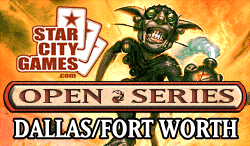Magic Technology has come a long way since the early years of the game. Just look at how many theoretical concepts we can talk about today, such as Card Advantage, Hoser/Hate, Hard/Soft Locks, Mana Curve, Tempo, Beatdown, Transformational Sideboard, Virtual Card Advantage, Deck-Thinning, The Philosophy of Fire, Aggro-Control, The Fundamental Turn, Reach, Threat Density, Semi-Soft Lock, Resiliency, Stages of Game Play, and Value. These ideas have their own unique properties when applied to Magic, and it is only through the efforts of a number of brilliant theorists and typically writers on the game that we have been able to develop this language for describing the physics of Magic.
Just as students of Chess can talk about how to fianchetto a bishop, or how to open up a closed position, so can we use our own terms to describe how to effect the game. Whereas this language was spoken by relatively few ten or fifteen years ago, these days, hundreds of thousands of experienced tournament players are at least reasonably versed in the “lingo.” However, something I have observed recently is that a much smaller percentage of players have a useful language for describing their preparation or deck building processes.
One of my early inspirations was the original successful Magic Book author, George Baxter. It blows my mind that so many students of the game, these days, have never even heard of George Baxter or his contributions to the game. Baxter never contributed the volume of theory or written work that Zvi (Zvi‘s book is available now!), Flores, edt, and many others have, but his contributions were an incredible boon to the community, as he helped pioneer the original push to approaching Magic from a scientific standpoint rather than the superstitious hocus-pocus and misinformation that made up the vast majority of theory on the game when it was initially released. He was one of the primary inspirations for Next Level Magic and is considered one of the founding fathers of Magic writing.
An early concept that Baxter pioneered was his system for organizing a decklist. The most famous element of this system is the use of “pockets” to talk about assortments of cards in a decklist, though the entire format of his “Deck Construction Worksheet” will probably look familiar to most readers.
I have included a sample of this style of worksheet, and I encourage deck builders both veteran and aspiring to print out numerous copies. I spent many hours of class drawing out deck construction worksheets in my notebooks, years ago, and what I didn’t realize until much later was that the process is useful beyond just as an organizational technique.
A few years ago, I was unable to get my hands on any actual Magic cards for a number of years, but I never stopped brewing. I longed to actually play games, though, and decided to take a page out of Adrian Sullivan playbook, using a deck construction worksheet as a chart to keep track of what playing cards represented in all proxy games.
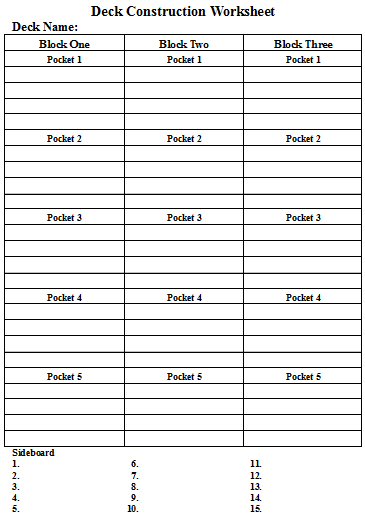
See, what Adrian taught me to do was to take a deck of playing cards, then add two more 4-ofs, such as jokers or jacks with a box draw along the edges (jack in a box…). The Deck Construction Worksheet is now used as a chart where Aces represent Block One-Pocket One, Two’s are Block One-Pocket Two, Sixes are Block Two-Pocket One, Regular Jacks are Block Three-Pocket One, and Joker’s are Block Three-Pocket Five.
Additionally, the four cards in the pocket would be marked by the four suits. Adrian used to like to go in “Bridge order.” However, I always went Hearts (at the top of a pocket)-Diamonds-Clubs-Spades (bottom of a pocket), as it felt more intuitive to me.
Sideboarding was just a matter of listing which cards get sideboarded in for which other cards, then using the proxies for what they now stand for. This system is ingenious, as it allows you to have a limitless number of proxy decks without ever having to write on cards. It has its limitations, however, most notably that it is much more likely to lead to human error. In addition, it is totally obnoxious to play against, and does not lead to as strong of a game being developed as written proxies, or especially the real thing. It is a matter of necessity that I use proxies at all, but there is no question that playing games with the real cards leads to an even greater proficiency with the deck in question.
Deck Construction Worksheets are not primarily for this, however. The greater advantage offered is that when constructing a deck, this format helps you view the deck as a whole and keep track of important elements, such as your mana curve and similarities to existing decks.
A common practice when using “Pockets” is to start by putting “One-Drops” in Block One-Pocket One and Block Two-Pocket One, two-drops in Block One-Pocket Two and Block Two-Pocket Two, and so on. In addition, your manabase should generally start in Block Three-Pocket Five and work its way up the right side, then continuing in the middle column starting at the bottom and working its way up. Cards that cost more than five are generally just inserted wherever seems logical when you get to them.
The first few times you fill out Deck Construction Worksheets you will probably find that you want to erase where you wrote a card and fill it in somewhere else. This is totally natural, though after a bit of experience with this format, you tend to be able to identify where to place cards from the start.
After a bit of experimentation with “Pockets,” I think you will find that you can’t help but look more carefully at the mana curve of your deck. You will start to notice similarities and differences between different decks and different archetypes. You will also finding yourself inspired to channel your thoughts in more logical ways with regards to answering questions about the direction the deck should take, as you will now have a more visual way of considering all of the data.
If this seems a bit silly, a bit too 1996, I suggest suspending your disbelief for a moment. While the system is not going to be the end-all, be-all system for deck building nowadays, it can teach you quite a bit about deck building as well as analyzing decks. The real value, though, is that it can teach you things that can’t be taught in an article. It can help you develop logical connections and give you tools for developing the system of deck building shortcuts that works best for you.
Besides, if nothing else, it really is a great organizational tool, because it not only keeps the information about the contents of your deck sorted in a logical way that can help you look at it as a whole, it also provides a convenient way to keep track of deck lists that you plan on studying or working with quite a bit without just having to resort to scribbled lists or typed up word documents. Keeping a three-ring binder full of deck lists that you have made or studied can be an invaluable tool for improving as a deck builder. This serves as more than just a reference material (though it is good at being that), it is also a way to examine your progress and what sorts of decks you have thought about over time.
Switching gears a moment, I would like to share a few words on some Worldwake cards that have been confirmed spoiled by our friends over on MTGSalvation.com. Before I do, however, I would like to take a minute to remind people running other spoiler websites to give credit where credit is due. I am all about everyone running their site however they want, and there is definitely room for more than one rumor site, but it is comical to see how many people just straight-up copy/paste whatever is currently spoiled on MTGSalvation.com, without crediting the source. This is not aimed at any particular site or sites. This is about everyone that runs a website that derives regular content from copy/pasting another and pretending that they aren’t. Let’s keep it legit, guys.
The first Worldwake card I want to talk about today is the mythic rare, Comet Storm.
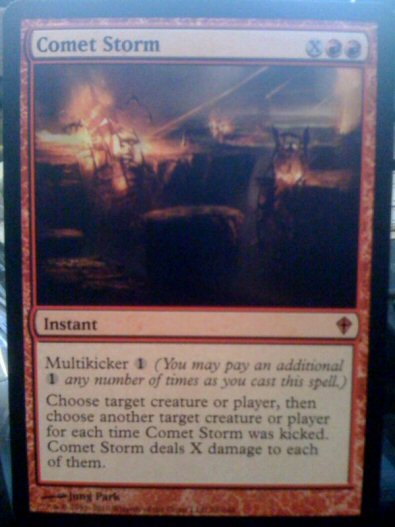
I apologize for the poor picture quality, as this is the only one I could find. For those that have trouble reading the text, the card is:
Comet Storm
XRR
Instant
Mythic
Multikicker 1 (You may pay an additional 1 any number of times as you cast this spell.)
Choose target creature or player, then choose another target creature or player for each time Comet Storm was kicked. Comet Storm deals X damage to each of them.
So, it’s a Fireball variant, sure, but how do we begin to evaluate this card? There is a lot of room between Demonfire and Fireball, versus Volcanic Geyser and Energy Bolt. Let’s start by trying to understand its power level in a vacuum. Of course, we don’t mean a true vacuum, as no card has any power at all without any context, but I mean a more general comparison to every card ever made.
To start with, it is fairly well established that Blaze is playable at times, depending on the context, but having a little bonus like Fireball or Demonfire or Banefire can go a long way to making it playable in more circumstances. This card is a Blaze with two fundamental advantages and one fundamental disadvantage.
First, the drawback: it costs an extra R. How big a deal is this? Name for me every good burn spell that ever cost XRR.
Go ahead, take your time. I’ll wait.
Obviously, when it comes to Limited, Blaze could cost XRR and still be a first pick bomb, but when it comes to Constructed, not even Rolling Thunder saw play. What this means is not that a card costing XRR is unplayable, but rather that is probably needs to be the best XRR card ever printed to have a realistic shot.
Let’s examine the upsides. First, the simplest upside is that it is an instant. Being an Instant is an incredible boon and could have major implications, but before we get too excited, we do need to remember that Volcanic Geyser, one of the better XRR cards, saw very little play, and back then creatures were terrible. That card would have no shot nowadays. None.
Comet Storm is a Volcanic Geyser with an added upside. How much is that upside worth?
Before you ask, you cannot choose the same target multiple times. Comet Storm says another target. However, unlike Fireball or Rolling Thunder, you don’t actually have to divide the damage at all, you just do the full amount. That means Comet Storm is actually a functional reprint of The Ultimate Nightmare of Wizards of the Coast Customer Service, though at Instant Speed and always for 1 colorless mana less (since Comet Storm gives you the first target for “free”).
How good was The Ultimate Nightmare of Wizards of the Coast Customer Service? It obviously never really had a chance to get tried out in serious tournament play. As a side note, the phone number that appears in the flavor text was the actual phone number for Wizards of the Coast Customer Service, which used to be the hotline that you could call when you didn’t understand how a card worked or to get a ruling.
Man, I miss being able to get rulings on demand! Obviously we have the internet these days, plus Riki and Sheldon on speed dial, but still…
How good is an instant speed The Ultimate Nightmare of Wizards of the Coast Customer Service for 1 less? Let’s look at how the card compares to Fireball, a card that can accomplish everything Comet Storm can, albeit at Sorcery speed.
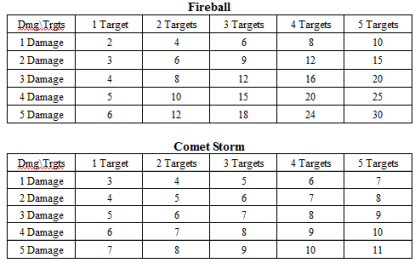
The number in each box is the total converted mana cost of the spell when it deals that much damage to that many targets. Obviously you don’t get taxed as heavily by Fireball when you only need to deal 1 damage to some of the targets and most of the damage to 1 target. However, Fireball will never come close to being as mana efficient as Comet Storm, except at the very lowest numbers of targets or amounts of damage dealt.
These charts make Comet Storm seem far more powerful than Fireball, and the truth is that it is more powerful, but the real question is this: is this a power we actually want? It sounds great to deal 5 damage to 5 targets for 11 mana instead of 30, but first of all, what game state are you picturing? Your opponent has 4 Baneslayers on the battlefield? Besides, 11 mana is a lot. Don’t get me wrong, these situations come up and aren’t actually even that rare… I am just saying we have to remember to keep this power in perspective.
Additionally, Cascade is really good right now. Really good. That means that X-spells are already coming from a handicap, since they decrease your ability to play Bloodbraid Elf. This is a very real cost. Opportunity cost must always be kept in mind when evaluating Magic cards.
So how good do I think Comet Storm is? My position on the card is probably not as much fun or controversial as with some cards, but I have the card being an Oblivion Ring type. Some people will think the card is busted in half. I think they overestimate it. Many people will say it is terrible. I think they underestimate it. In the end, the card will turn out to be a tournament staple, seeing a fair amount of play, but not shaking things up terribly.
I think it is more probable that the card will turn out to be a stud than a dud, but overall, I see it being a useful role-player. Unlike Oblivion Ring, the card is a Mythic Rare, so it won’t necessarily be that cheap to acquire. Still, the card is hardly going to be a must-own or a must-play, so it won’t be that expensive at all (no more than a random Planeswalker, at the most, I would guess).
When it comes to in-game applications, I think the card has some real possibilities contextually. The card’s power level has to be far higher than previous X-spells to be able to compete with cards like Baneslayer Angel, Bloodbraid Elf, Putrid Leech, Rhox War Monk, Sprouting Thrinax, Vampire Nighthawk, and so on, but it does have some things in its favor.
First of all, it is a very effective solution to Planeswalkers, though it should be noted that you can’t pay 6 to Comet Storm Jace for 3 and your opponent for 3, though surely many players will try (either cheating or inadvertently). When you Comet Storm, you choose your opponent as the target, then redirect to Jace. Jace is not the target.
However, you can pay 6 to deal 3 to Garruk and 3 to the Beast. You could also spend 9 to kill two Baneslayers and an Elspeth. I realize that is a lot of mana, but it does create a pretty big impact on the board and can usually be cashed in for a moderately costed one-for-one. The thing is, we already have this card…
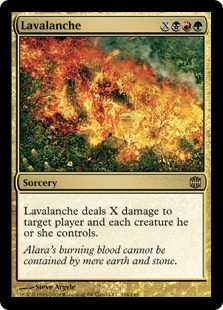
Lavalanche is effectively a Comet Storm for all their guys and them, but instead of paying a mana for each extra target, you always just pay as though it was two targets. Lavalanche has slightly more power in this sense, though Lavalanche is a three color combination and is certainly not an instant.
The key to Comet Storm is going to be getting enough value out of it at instant speed (hitting a Ball Lightning for 3 mana, killing a Jace the Mind Sculptor that just hit play, or just providing a huge instant speed threat), as well as getting value out of the ability to hit multiple targets. This is an ambitious task, as spending that much mana inevitably forces you to compare the card to cards like Cruel Ultimatum, Baneslayer Angel, Martial Coup, and so on (also known as Mind Spring syndrome, where you justify playing a bad “Big Card” because of the promise of being able to cash it in for moderate value, should you need to).
My rating? A cautious “Decent.”
Up next…
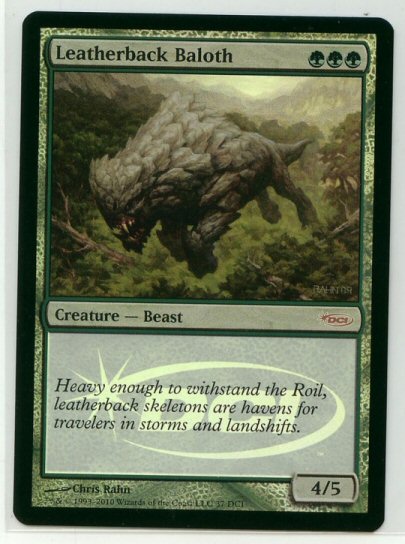
Leatherback Baloth
GGG
Creature- Beast
4/5
This guy seems pretty straightforward. He is from the same school of costing as Woolly Thoctar, with what many would consider to be the slightly worse 4/5 instead of 5/4 for the slightly easier (?) cost of GGG instead of RGW.
Just on stats, the guy is at least worthy of our attention. People are always going to be able to find fault with such a vanilla creature, but the truth is, this guy is generally as big as most decent sized Tarmogoyfs. Obviously GGG is more than 1G, but no one ever claimed he was as good as Tarmogoyf.
He does have the advantage of requiring no set-up work, unlike Tarmogoyf. Besides, Ernham Djinn did pretty well for himself at 4 mana for a “vanilla” 4/5, so maybe this guy helps fill out the “Vanilla 4/5 curve” (with Goyf at two). It should also be noted that he is a natural should Shadowmoor and Eventide’s theme of mana symbols matter continue, or should some other similar mechanic be created.
Personally, I see this guy being similar to Woolly Thoctar, in that people looking for the biggest three-drop their color combination has will use him. No big deal, not ground breaking, just a better default three-drop for a Green Deck that doesn’t care for the Sable Stag’s abilities.
The fact that he is a Beast should be kept in mind, as that is a type that WotC may want to help a bit at some point, and he is a natural fit with Oran-Rief the Vastwood. His low casting cost makes it easy to have an extra mana to give him the boost, plus 5/6 gets through Baneslayer (though 4/5 gets through Bituminous Blast and Rhox War Monk anyway). I do see this guy dying to Gatekeeper of Malakir though…
As far as Limited goes, it will be interesting to see if this guy turns out to be rare, or as some people say, common. Personally, I hope he is not Common, though Uncommon would be fine.
Up next…
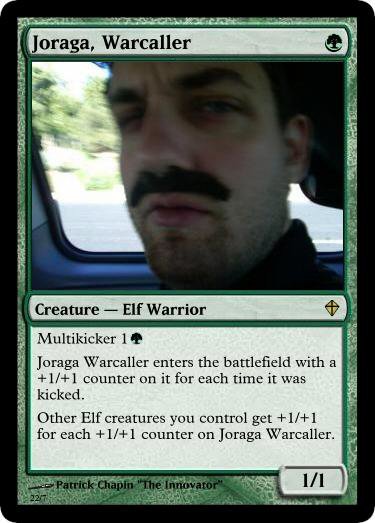
Joraga Warcaller
G
Creature- Elf Warrior
Rare
Multikicker 1G
Joraga Warcaller enters the battlefield with a +1/+1 counter on it for each time it was kicked.
Other Elf creatures you control get +1/+1 for each +1/+1 counter on Joraga, Warcaller.
1/1
Not bad!
Joraga Warcaller is rumored to be a release promo, and will obviously appeal to casual players as yet another Elf Lord, but what about the tournament players? Does this guy have what it takes to help out a Nissa Revane deck, such as Eldrazi Green?
Just how much do you need to kick the Warcaller for it to be worth it? Obviously a 1/1 for G is not interesting, though it can be a way to jump start your Archdruid and you can certainly play a turn 1 Oran-Rief, turn 2 Joraga Warcaller. As a matter of fact, at just about every stage of the game, Oran-Rief is going to work very well with this guy.
As a three-drop, the Warcaller is essentially the quintessential lord, a 2/2 that gives your tribe +1/+1. He doesn’t have the abilities of Imperious Perfect or Elvish Champion, though he might have some surprising synergy with any way to put +1/+1 counters on a creature, such as Jund Charm, Ajani Goldmane, Mark of Mutiny, or Naya Sojourners.
Once you start talking about a Warcaller for 5 or more mana, things get out of hand very quickly. The thing about the Warcaller, however, is that he lends himself to decks that naturally come into large amounts of mana with a shortage of things to spend it on. This makes him a perfect fit. No one that plays Elvish Archdruid has gone long without accidentally ending up with nine mana on turn 5. The Warcaller is an ideal way to spend this mana, and if you have enough Elves to make the Arch Druid make a ton of mana, than you will probably have enough Elves to make the Warcaller’s ability game breaking.
This guy is a nice one, and while he won’t break any formats, will be every bit the tournament card that Elvish Archdruid is, especially as long as he has Nissa Revane ensuring that people will be able to produce a respectable number of actual Elves. He is just a solid, efficient lord that gains a lot of value from his flexibility. He is good at the lowest setting and good when you sick a million mana into him. Two thumbs up. Keep your eyes open for any new cards that put +1/+1 counters on creatures, as I wouldn’t be surprised if WotC stuck a premade “deck” in Worldwake, by printing something like:
Get Big
GGG
Instant
Uncommon
Put three +1/+1 counters on target creature.
This is not a real card. I am just suggesting to keep your eyes open for anything along these lines, as it is totally R&D’s MO to stick internal synergies like that into sets. Seeing them first can give you an advantage over everyone else when it comes to predicting the direction the format will go.
I hope everyone had a Happy Holiday and is prepared to make 2010 the kind of year they would be proud to have lived. See you next week, when we talk Extended, getting ahead of the curve in a PTQ season, and more Worldwake!
Patrick Chapin
“The Innovator”

